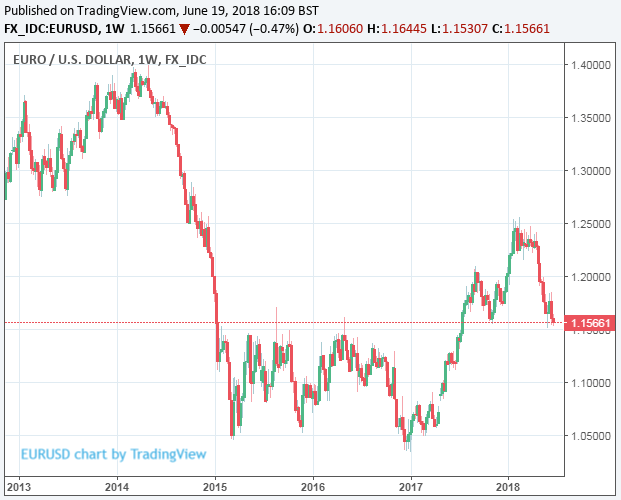EUR/USD "Attractive" Below 1.16 say Morgan Stanley
- Written by: James Skinner
-

© artjazz, Adobe Stock
The Euro-to-Dollar rate is "attractive" at current levels, according to strategists at Morgan Stanley, who are arguing that the recent sell-off sparked by the European Central Bank (ECB) last week has left the single currency positioned for a strong recovery over the longer term.
They argue that the ECB's shrinking role in the Eurpean bond market, and its latest guidance on Eurozone interest rates, will mean the single currency becomes an increasingly attractive prospect for international investors in search of higher returns. The short-term outlook is positive too.
"We fade the selloff in EUR and European currencies in the wake of the ECB's provision of calendar guidance on the timing of the first rate hike. The USD weakening trend should keep EURUSD supported. Positioning also favors EURUSD higher," Gek Teng Khoo, an FX strategist at Morgan Stanley, says of the short-term outlook.
Morgan Stanley's call comes as EUR/USD sits close to a one-year low, trading at a -3.59% 2018 loss, after its previous uptrend was broken in recent months by a resurgent US Dollar and an ECB that is at pains to prevent markets from becoming too opitimistic about the outlook for Eurozone interest rates.

Above: Euro-to-Dollar rate shown at daily intervals.
It also follows the June monetary policy announcement from the ECB, which saw Mario Draghi crush market hopes that the bank might raise interest rates from their record lows in June 2019. This dealt a blow to the single currency and a large community of forecasters who had hoped an end to the era of record low interest rates was near.
Such was the market angst over Draghi's guidance, the Euro sold off by close to 300 points against the Dollar, despite that the ECB also announced a surprise end to its quantitative easing (QE) programme. Morgan Stanley suggest there may be a silver lining in the recent moves for investors.
"The ECB is providing the market with the impetus for a steeper European Government Bond (EGB) yield curve, as net asset purchases ending coupled with a lower-for-longer path of front end rates should keep EGBs on a steepening trajectory. We believe the pace of the European economic recovery will only bolster this process further," says Hans Redeker, head of foreign exchange strategy at Morgan Stanley.
Redeker says a "steeper curve" acts as an incentive for investors to hedge their currency exposure when buying local currency assets, which in this case would involve betting against the Euro at the same time as buying it to invest in the continent's bond market.
If hedging, investors would not benefit from any increase in the value of the Euro throughout the life of their investment, but they would not lose out in the event that it continues to fall either. So the effect of European Central Bank policy further down the line is what matters most for the single currency now.
"The capital inflow helping local assets to rally can spark future currency-unhedged positions. Moreover, the improvement in financial conditions provided by these flows supports the growth outlook. Finally, a steeper curve works in favor of bank profitability and may support lending as well, fuelling further recovery and growth," Redeker writes. "This is why a steeper curve supports a currency, explaining why we view EURUSD below 1.16 as attractive from a longer-term perspective."

Above: Euro-to-Dollar rate shown at weekly intervals.
Morgan Stanley's view is noteworthy because the bank was among the first to call an April turn in market sentiment toward the US Dollar, which duly saw the greenback convert a 4% 2018 loss into a 3% gain. The bank's strategists were also betting against the Euro-to-Dollar rate until recently, having advocated in April that clients sell EUR/USD "short" around the 1.24 threshold and target a move down to 1.16, which is a move that has now played out to the letter.
However, Morgan Stanley are not alone in eyeing the possibility of a Euro renaissance over the medium-to-longer term. Strategists at Societe Generale, another of the world's top investment banks, wrote this week that a rebound is likely to occur within the next 12 months. Others have also come out in favour of a swift correction higher over the next six months.
"We expect a move to a more neutral valuation, around EUR/USD 1.30, over the next 6-12 months, once ECB policy normalisation is on track and the latest EU crisis has calmed down," says Kit Juckes, chief FX strategist at Societe Generale. "That said, the June-August period is likely to remain volatile as the new Italian government outlines its policies. We would not be surprised to see EUR/USD trade below 1.15 before it resumes its recovery."
Advertisement
Get up to 5% more foreign exchange by using a specialist provider to get closer to the real market rate and avoid the gaping spreads charged by your bank when providing currency. Learn more here





